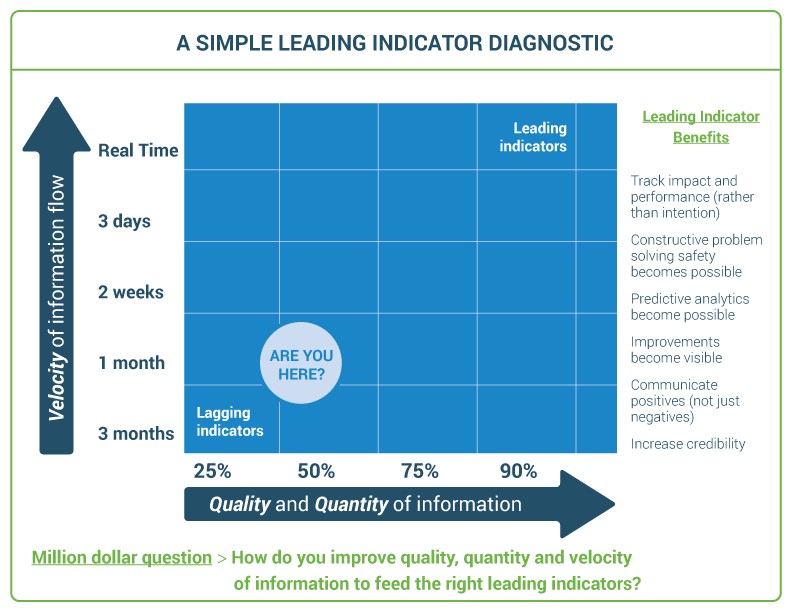
PUBLISHED
August 15, 2016
WRITTEN BY
Victoria Formosa
When considering how to apply best practices to your company’s safety management, it’s impossible to ignore the importance of leading indicators. However, few mid-sized organizations are able to successfully make use of leading indicators within their regular processes as a method of continuous improvement.
According to the National Safety Council and Campbell Institute, while 89% of organizations viewed leading indicators as extremely or very important, 61% of organizations had an imbalance in favor of lagging indicators, and 69% of organizations had difficulty identifying corrective or preventative actions from leading indicators. The results of the study show that organizations understand the importance of leading indicators at a high level, but seem to have difficulty implementing and maintaining them throughout their organization.
How do safety and operational professionals often articulate this frustration?
Every day, safety professionals are burdened with a significant number of administrative tasks rather than the things they know will make a difference to workplace safety. From incident reports, to tracking training requirements, to maintaining compliance with legislations, the tasks on their “to-do” lists are often endless. When they’re only getting a third of the information that they should be getting from the field and are spending the majority of your time in the collection and gathering stages, reporting and forecasting using leading indicators is often deprioritized.
We know there are several benefits to leading indicators, but without properly implementing them, you aren’t getting the full benefits of all your hard work. We’ve highlighted the top three areas to focus on to ensure success with executing leading indicators.
1. Defining the Right Leading Indicators
Ask yourself what the risks are, the controls for those risks, and the leading indicators that can directly link to those controls or risks? Once you’ve defined your leading indicators, prioritize them in relation to your company, and ensure your list is as up to date as possible at all times.
2. Improve your Information by Defining Quality and Quantity
Try predicting the outcome of your favorite sports team’s next game without knowing their history of performance vs. the opposition. In the same example, imagine if you knew who won or lost but didn’t know the score. Quantitative and qualitative information both work in tandem toward driving better decisions. Acquiring more relevant information results in more meaningful and accurate leading indicators.
3. Ensure your information is in “Real-Time”
The accuracy of your information is what determines how valuable it will be to your organization. With mission critical safety information at our disposal on a daily basis, we need to ensure the velocity of our information is constantly improving.

As shown in the simple diagnostic above, it’s often hard for many safety professionals to move to the upper right hand corner of the spectrum with their current safety practices. The question still remains “how can you improve the quality, quantity, and velocity of information to feed the right leading indicators?” Ultimately, in organizations with different sites/departments, organizational layers, and constant change, we must embrace straight-forward technology to push our information quality/quantity in the direction of real-time information.
Putting systems in place, including technology can help you isolate and gauge leading indicators as you continuously evaluate and monitor your safety or risk program. Safety leaders need to decide where on the velocity/quality & quantity spectrum their organization needs to be to have the confidence that their safety
and business performance will meet their organizational goals.
By focusing on the simple leading indicator diagnostic, organizations will be able
to decipher between knowing what leading indicators are, to actually using them effectively.
Empower Your Employees
& Protect Your Business
We can make effective changes to
your health and safety processes.
Learn how Lisbon Valley reduced time allocated to administrative tasks by 79%.
READ CASE STUDY →